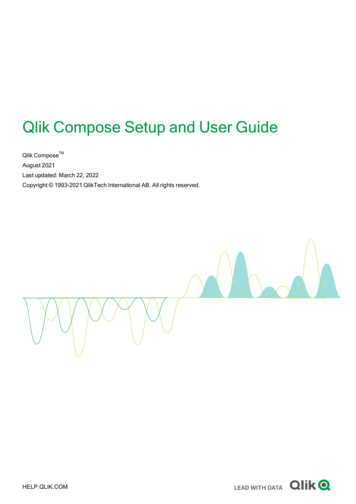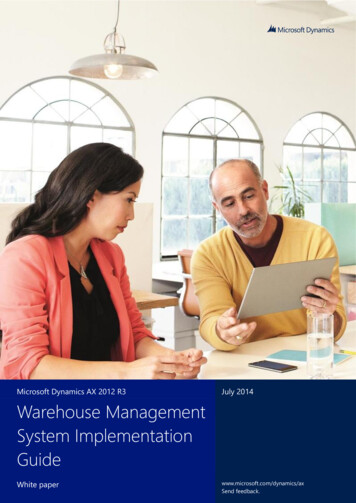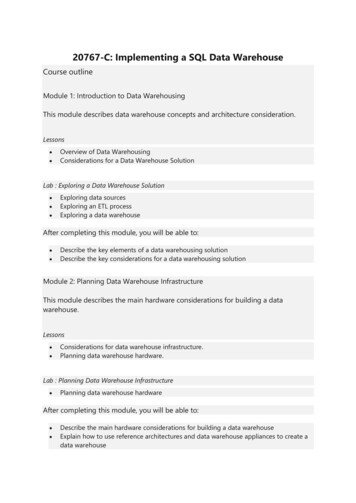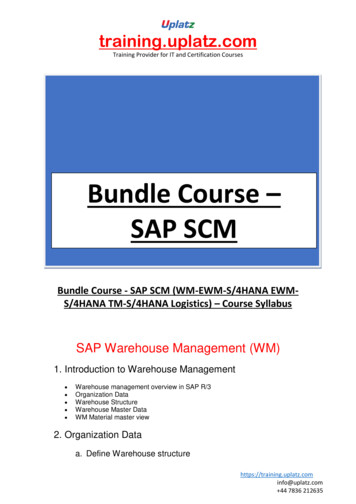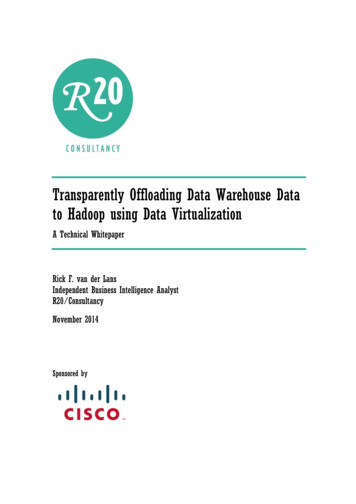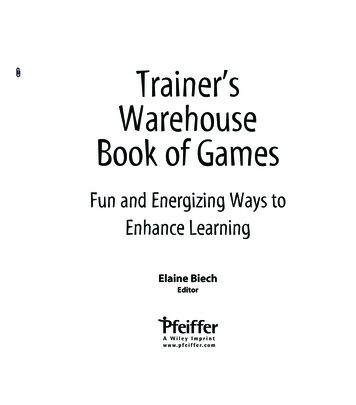
Transcription
Trainer’sWarehouseBook of GamesFun and Energizing Ways toEnhance LearningElaine BiechEditorffirs.indd v2/2/08 4:44:17 PM
ffirs.indd ii2/2/08 4:44:15 PM
About This BookWhy is this topic important?Trainers, educators, consultants, and presenters depend on Trainer’s Warehouse to supply them withcreative as well as practical, exciting as well as useful tools, props, materials, and, yes, toys for theirlearners. This book takes that service one step further, providing activities and games that customerscan use with the wonderful array of tools they have purchased from the company. Did you purchasea boomwhacker? Wondering how to use it? Check the Trainer’s Warehouse Materials List at the endof the book. It will lead you to activities during which you can use it.What can you achieve with this book?This book offers you a selection of over one hundred activities, games, and trainer tools and techniques. Every activity is supported by materials from Trainer’s Warehouse and was tested by satisfiedcustomers like you. Turn to Trainer’s Warehouse Book of Games for a rich source of ideas and to tryout new classroom tools, toys, and approaches that others in your profession have found successful.The activities will add loads of learning and fabulous fun to your next training session.How is this book organized?The book is divided into three sections and twenty-two chapters. Section One, What’s Ahead, helpsyou understand the purpose of the book. Section Two, Training Tools and Techniques, includes tenchapters. Each of the chapters represents training techniques that may be incorporated into manytraining sessions, including openings; icebreakers; energizers; participation encouragement; comprehension and retention; time and people management; training techniques; rewards andrecognition; review of knowledge and skills; and closings. These chapters are ordered in the typicalchronological appearance of these techniques in a workshop or training session. All will enrich yourtraining design. Section Three, Training and Consulting Topics, also includes ten chapters. Each chapter represents a specific training topic: change management; communication and trust; creativity;customer service; organization knowledge; personal development; problem solving; process andprojects; supervision, management, and leadership; and teamwork and team building.ffirs.indd i2/2/08 4:44:15 PM
ffirs.indd ii2/2/08 4:44:15 PM
About PfeifferPfeiffer serves the professional development and hands-on resource needs oftraining and human resource practitioners and gives them products to do theirjobs better. We deliver proven ideas and solutions from experts in HR development and HR management, and we offer effective and customizable tools toimprove workplace performance. From novice to seasoned professional, Pfeifferis the source you can trust to make yourself and your organization moresuccessful.Essential Knowledge Pfeiffer produces insightful, practical,and comprehensive materials on topics that matter the most to training and HR professionals. Our Essential Knowledge resources translate theexpertise of seasoned professionals into practical, how-to guidance on criticalworkplace issues and problems. These resources are supported by case studies,worksheets, and job aids and are frequently supplemented with CD-ROMs,websites, and other means of making the content easier to read, understand,and use.Essential Tools Pfeiffer’s Essential Tools resources save time andexpense by offering proven, ready-to-use materials—including exercises, activities, games, instruments, and assessments—for use during a trainingor team-learning event. These resources are frequently offered in looseleaf orCD-ROM format to facilitate copying and customization of the material.Pfeiffer also recognizes the remarkable power of new technologies inexpanding the reach and effectiveness of training. While e-hype has often created whizbang solutions in search of a problem, we are dedicated to bringingconvenience and enhancements to proven training solutions. All our e-toolscomply with rigorous functionality standards. The most appropriate technology wrapped around essential content yields the perfect solution for today’son-the-go trainers and human resource professionals.Essential resources for training and HR professionalsw w w. p f e i f f e r. c o mffirs.indd iii2/2/08 4:44:16 PM
For Shane and Thad,thanks for energizing me.—Elaine Biechffirs.indd iv2/2/08 4:44:17 PM
Trainer’sWarehouseBook of GamesFun and Energizing Ways toEnhance LearningElaine BiechEditorffirs.indd v2/2/08 4:44:17 PM
Copyright 2008 by John Wiley & Sons, Inc. All Rights Reserved.Published by PfeifferAn Imprint of Wiley989 Market Street, San Francisco, CA 94103-1741www.pfeiffer.comExcept as specifically noted below, no part of this publication may be reproduced, stored in a retrieval system,or transmitted in any form or by any means, electronic, mechanical, photocopying, recording, scanning, orotherwise, except as permitted under Section 107 or 108 of the 1976 United States Copyright Act, withouteither the prior written permission of the Publisher, or authorization through payment of the appropriate percopy fee to the Copyright Clearance Center, Inc., 222 Rosewood Drive, Danvers, MA 01923, 978-750-8400,fax 978-646-8600, or on the web at www.copyright.com. Requests to the Publisher for permission should beaddressed to the Permissions Department, John Wiley & Sons, Inc., 111 River Street, Hoboken, NJ 07030,201-748-6011, fax 201-748-6008, or online at http://www.wiley.com/go/permissions.Limit of Liability/Disclaimer of Warranty: While the publisher and author have used their best efforts in preparingthis book, they make no representations or warranties with respect to the accuracy or completeness of thecontents of this book and specifically disclaim any implied warranties of merchantability or fitness for a particularpurpose. No warranty may be created or extended by sales representatives or written sales materials. The adviceand strategies contained herein may not be suitable for your situation. You should consult with a professionalwhere appropriate. Neither the publisher nor author shall be liable for any loss of profit or any other commercialdamages, including but not limited to special, incidental, consequential, or other damages.Readers should be aware that Internet websites offered as citations and/or sources for further information mayhave changed or disappeared between the time this was written and when it is read.Certain pages from this book are designed for use in a group setting and may be customized and reproducedfor educational/training purposes. The reproducible pages are designated by the appearance of the followingcopyright notice at the foot of each page:Trainer’s Warehouse Book of Games. Copyright 2008 by John Wiley & Sons, Inc. Reproducedby permission of Pfeiffer, an Imprint of Wiley. www.pfeiffer.comThis notice may not be changed or deleted and it must appear on all reproductions as printed.This free permission is restricted to limited customization of the CD-ROM materials for your organization andthe paper reproduction of the materials for educational/training events. It does not allow for systematic or largescale reproduction, distribution (more than 100 copies per page, per year), transmission, electronic reproductionor inclusion in any publications offered for sale or used for commercial purposes—none of which may be donewithout prior written permission of the Publisher.For additional copies/bulk purchases of this book in the U.S. please contact 800-274-4434.Pfeiffer books and products are available through most bookstores. To contact Pfeiffer directly call our CustomerCare Department within the U.S. at 800-274-4434, outside the U.S. at 317-572-3985, fax 317-572-4002, orvisit www.pfeiffer.com.Pfeiffer also publishes its books in a variety of electronic formats. Some content that appears in print may not beavailable in electronic books.Library of Congress Cataloging-in-Publication DataTrainer’s Warehouse book of games : fun and energizing ways to enhance learning / Elaine Biech, editor.p. cm.Includes bibliographical references.ISBN 978-0-7879-9092-3 (pbk.)1. Employees—Training of. 2. Organizational learning. 3. Experiential learning. 4. Educationalgames. 5. Group games. I. Biech, Elaine. II. Trainer’s Warehouse (Firm)HF5549.5.T7T6636 2008658.3'124—dc222007049560Acquiring Editor: Martin DelahoussayeEditor: Rebecca TaffDirector of Development: Kathleen Dolan DaviesEditorial Assistant: Marisa KelleyDevelopment Editor: Susan RachmelerManufacturing Supervisor: Becky MorganProduction Editor: Dawn KilgorePrinted in the United States of AmericaPrintingffirs.indd vi10 9 8 7 6 5 4 3 2 12/2/08 4:44:17 PM
ContentsPrefaceAppreciationSection 1: What’s AheadChapter 1: Experiencing Learning: The Whys andHows of Involving ParticipantsChapter 2: Setting the Stage for Playful LearningSection 2: Training Tools and TechniquesChapter 3: OpeningsGetting to Know You Differentlyxvxvii1311212324Marcia A. ChambersYou’re a Superhero27Amy DrennenFun Caps Versus Boring Tent Cards30Bruce GrahamTopic Walk33Mohandas NairChapter 4: IcebreakersShake It Icebreaker3738Sunny BradfordRed Light, Green Light40Mike DoctoroffTents Tell All—Myriad Uses for Table Tents43M.K. KeyThe Hats We Wear46Lorraine KohartToys Are Us48Karen Lawsonviiftoc.indd vii2/2/08 4:45:34 PM
Who’s on My Team?51Edwin MourinoPress Conference54Linda M. Raudenbush and Steve SugarThis Treasure Is Me58Harriet RifkinChapter 5: Energizers61Non-Trash Trash Can62Kathy Cleveland BullCall Me Princess Java64Holly M. O’NeillSurprise Info66Jan M. SchmucklerEverybody Dance68Sion SegalChapter 6: Participation EncouragementI’m No Chicken Award7172Dawn BrennerShare, Scratch, and Win75Beth DuckerHigh Five78Sion SegalRapid-Fire Review80Nicole WaltonPick It Up!82Devora ZackChapter 7: Comprehension and RetentionThe Organic Quiz Show8788Halelly AzulayMonster MNEMONIC Maker91Susan Doctoroff LandayContinuous Learning Review93Mohandas Nairviiiftoc.indd viiiContents2/2/08 4:45:34 PM
Chapter 8: Time and People ManagementMoney for Trivia9596Patricia BurggraffWheel of Consequences99Carolyn E. ConwayBreak Time—Roll the Dice!102Amy HendersonLet’s Return104Lou RussellPrize Roulette107Linda M. Raudenbush and Steve SugarThe Chicken Rules110Carson Key WhiteheadCell Phone Attack113Cris WildermuthChapter 9: Training TechniquesMagic Coloring Book117118Carrie GendreauName Tent Teams121Amy HendersonTicket Mixer to Assign Groups124Cindy HuggettFiddle While You Learn127Linda M. RaudenbushMusic Makes the Training Go Round130Marjorie TreuBirthday Ball133Yvette ZgoncChapter 10: Rewards and RecognitionTeam Challenge135136Yara AlmodovarYou’re a Star!140Jan Ferri-ReedWanna Deal or Not?142Stacy LowmanContentsftoc.indd ixix2/2/08 4:45:34 PM
Chapter 11: Review of Knowledge and SkillsKoosh Ball Review145146Victoria ArellanoStick ‘em Up Review148Ruby A. BohannonContent Relay151Carol A. DawsonGoal Setter Game155Mike DoctoroffAlphabet Review158Amy DrennenPleasure Island Review161Amy DrennenSqueeze Play Course Review164M.K. KeyDartboard Learning Review166Susan Doctoroff LandayWhaddaya KnowTM?169Susan Doctoroff LandayBull’s Eye Bowl172Linda M. Raudenbush and Steve SugarIs the Answer Correct?175Marjorie TreuChapter 12: ClosingsThe Good Apple Award177178Marci GoldshlackCrazy, Cool, Creative Closing180Lois B. Hart“Peers Cheer Peers” Awards Ceremony184M.K. KeyIt’s Your Choice187Lou RussellThe Real Challenge190Edie Westxftoc.indd xContents2/2/08 4:45:35 PM
Section 3: Training and Consulting Topics193Chapter 13: Change Management195Change That Tune196Elaine BiechShaping Our Fortune198Sunny BradfordChapter 14: Communication and TrustThe Power of Non-Verbals203204Cindy Lee HallConstructive Feedback Key Pointers206Harriet RifkinSNAP210Bruce G. WaguespackSuper Forts for Super Teams213Devora ZackChapter 15: CreativityBrainstorming 101217218Kristin J. ArnoldCreative Idea Generation221Elaine BiechBrainstorming Boost223Teri LundOpposite Brains226Linda S. MillsGetting to Know You Feud228David PiltzChapter 16: Customer ServiceCustomers—Up Close and Personal231232Niki Nichols“Role” of the Die235Travis L. RussChapter 17: Organization KnowledgeThe Good, the Bad, and the Ugly New Manager239240Elaine BiechContentsftoc.indd xixi2/2/08 4:45:35 PM
Developing Core Values243Amie DeveroSpinning the Organizational Culture246Linda M. Raudenbush and Steve SugarOrganizational Lingo Crossword Puzzle250Johanna ZittoChapter 18: Personal DevelopmentSee the Light to the Power of Positive Thinking253254Dennis E. GilbertIf Life Gives You Lemons . . .261Elizabeth A. SmithThe Object of My Discussion265Randy WoodwardTruth or Chicken267Randy WoodwardI Appreciate My Job270Marty Yopp and Michael KrothExpress Expressions273Devora ZackChapter 19: Problem SolvingProblem Solving Line Up277278Cindy Lee HallCat-A-PultTM Challenge281Susan Doctoroff LandaySTAR Principle288Linda S. MillsTrue Colors290Terry MurraySpaghetti and Gum Drops293Bruce G. WaguespackGo for the Goal: Influencing Performance to Reduce Shortage296Johanna ZittoChapter 20: Process and ProjectsBright Idea305306Daniel Greenexiiftoc.indd xiiContents2/2/08 4:45:35 PM
Puzzling About Systems Thinking308Diane HamiltonProject Change Challenge313Sarah E. HurstChicken, Salad, and Koosh Ball Shuffle317Bruce G. WaguespackChapter 21: Supervision, Management, and LeadershipAppraising Performance: A Home Building Challenge323324Cindy Lee HallGetting Things in Focus: Koosh Ball Mania332Cher HoltonLeadership Essentials335Kitty Preziosi and Robert C. PreziosiYour Supervisor Hat338Marjorie TreuChapter 22: Teamwork and Team BuildingSkills on a Stick341342Elaine BiechSpinning Discovery345Elaine BiechGetting to Know You349Leonard D. GoodsteinMarble Run352Susan Doctoroff LandayCertifying Your Self-Image355Ira J. MorrowAcknowledging Our Team Resources357Terry MurrayThe Red and Black Game360Linda Russell and Jeffrey RussellKoosh —Koosh 368Linda M. Raudenbush and Steve SugarBy the Numbers372Rodney C. Vandeveer and Alexander W. CrispoContentsftoc.indd xiiixiii2/2/08 4:45:36 PM
Egg Drop Group376Bruce G. WaguespackDomino Effect379Devora ZackMore Than Meets the Eye382Devora ZackPrimary and Alternative Uses of ActivitiesTrainer’s Warehouse MaterialsContributorsAbout the Editorxivftoc.indd xiv385393409417Contents2/2/08 4:45:36 PM
PrefaceWho’d have thought that a father-daughter team, a Williams College physicist and aYale graduate, would manage a catalog company that strives to bring fun and inspiration to trainers, facilitators, educators, and presenters? Trainer’s Warehouse’s mission is to be a full resource of hard-to-find and innovative products that do just that.In 1994, Michael Doctoroff left a secure job and began making picture framesin his basement, and Office Images, Inc., was born. Orders for one to twentyfive frames for office cubicles arrived weekly. One day, two orders arrived, eachrequesting over five hundred frames. To his surprise, Mike learned that both buyersintended to use the frames for training certificates. Within months, Mike renamedthe company Trainer’s Warehouse and committed to finding and creating productsthat enabled trainers to do their jobs better.Susan Doctoroff Landay joined the company in 1997. Her experience in training and marketing and as a Ringling clown provides a solid background for theTrainer’s Warehouse strategy. The company’s first twelve-page two-color catalogfeatured thirty items. Today, the full-color catalog has multiplied in size and offersover 350 products, including more than one hundred exclusive items.Many trainers, educators, consultants, and presenters depend on Trainer’sWarehouse to supply them with creative as well as practical, exciting as well asuseful tools, props, materials, and, yes, toys to “entertrain” their participants.This book features learning activities used by many of the company’s satisfiedcustomers. Here’s what you’ll find in the book’s three sections. Section One serves as an introduction to the activities. One chapter sharessome insight into activities and learning offering some great debriefing questions for any game or learning activity. The second chapter sets the stage andcreates an environment of fun and experiential learning. Section Two focuses on Training Techniques. Every trainer and educator whohas a need for a new and different icebreaker or energizer, searches for betterways to ensure participation and retention, and wants creative ways to reviewmaterial and close sessions, will find ideas here. Section Three provides a collection of activities geared toward specific workshop topics using the many items found in the Trainer’s Warehouse catalog.Topics are in alphabetical order and range from Change Management toTeamwork and Team Building.xvfpref.indd xv2/2/08 4:47:52 PM
Already own a number of Trainer’s Warehouse items? Looking for new ways touse them? The Trainer’s Warehouse Materials list at the end of the book will leadyou to other techniques to use with the same items. Additionally, at the back of thebook, there is a grid of Primary and Alternative Uses for Activities, so you can seehow some of your favorites might be applied to other topical areas.Like the Trainer’s Warehouse mission, this book will bring ideas, fun, and inspiration to trainers, facilitators, educators, and presenters. Enjoy!xvifpref.indd xviPreface2/2/08 4:47:53 PM
AppreciationThanks to the contributors who have added substance and functionality. Yourconstructive contributions have produced a work that will be appreciated byyour colleagues.Susan Landay and Michael Doctoroff, thank you for entrusting me withyour resource-rich catalog and loyal customers. Here’s another product for yourcreative catalog.Martin Delahoussaye, editor, thank you for another inspirational idea for theprofession.Lorraine Kohart, ebb associates inc, this is more your book than mine. Thanksfor your extraordinary effort, persistent prodding, and your fresh focus.Dan Greene, thanks for your steady support.Susan Rachmeler, developmental editor, thank you for your practical ideas andyour uncommonly common sense.xviiflast.indd xvii2/2/08 4:48:25 PM
Section 1What’s Aheadp01.indd 12/2/08 4:48:59 PM
This section introduces Trainer’s Warehouse and presents the purpose of this book.The section helps you set the stage and create an environment conducive toexperiential learning and introduces the concept of using fun when learning.It also offers several key background tips so that you can be successful inintroducing, conducting, and debriefing an exercise.2p01.indd 2Trainer’s Warehouse Book of Games2/2/08 4:49:03 PM
Chapter 1Experiencing Learning:The Whys and Hows ofInvolving ParticipantsTraining and developing others is one of the most exciting and rewardingjobs anyone can have. You can affect the lives and work of many people,and influence individuals abilities to be successful, while at the same time have asignificant role in increasing your company’s bottom line.This chapter introduces you to a couple of concepts that will ensure yoursuccess as a trainer. It acquaints you with the concept of experiential learningactivities, sometimes called ELAs. It also provides several tactics for working withparticipants who believe they are “too serious” to have fun while they are learning.Using Experiential Learning ActivitiesExperiential learning happens when a learner participates in an activity, processes the activity, identifies useful skills or knowledge, and transfers the learningto the workplace or life in general. ELAs attempt to imitate daily life experiences.Participants “experience” what they learn before processing or discussing theactivity.To be successful, ELAs must have all of the following characteristics: Have a structure, including specific steps and a process that will lead toanticipated results Focus on a specific goal Incorporate a high level of participation3c01.indd 32/2/08 4:25:35 PM
Provide concepts, information, and data for participants to review and analyze Require processing or debriefing so that participants can uncover the learningthat occurredThe Experiential Learning Cycle (Reference Guide, 1999) identifies fiverequired steps of experiential learning activities: experiencing, publishing,processing, generalizing, and applying.Step 1, Experiencing. Participants complete a defined task, often usingprops, toys, and materials such as those from Trainer’s Warehouse. The activitymay be associated with a game or fun. If the process ends here, learning is left tochance. Therefore the trainer or facilitator leads the participants through a series ofquestions.Step 2, Publishing. Participants share their observations of what happenedduring the activity. Generally the trainer or facilitator guides the discussion withcarefully crafted questions. Participants have an opportunity to share what theyobserved and experienced and how it felt. The trainer usually begins with a broadquestion such as, “What happened?” and then focuses on the more specific questions that lead participants to the learning outcome for the specific activity.Give participants an opportunity to share observations. You may beginwith broad questions and then focus on more specific concepts. Here are someexamples: What happened?What did you observe?What helped or hindered the process?What results did you see?Did anything surprise you? What and why?How do you feel about what happened?Step 3, Processing. Participants have an opportunity to discuss thedynamics and results of the activity. In some cases observers may also be used tohelp define what occurred. This step helps participants interpret why somethinghappened.The key here is to allow participants to discover this for themselves, avoidingyour desire to “tell” them why. Ask questions such as these: 4c01.indd 4Why do you suppose that occurred?What did you learn about yourself? About others?What can you glean from this activity?What principles might be true based on your experience?Trainer’s Warehouse Book of Games2/2/08 4:25:36 PM
Step 4, Generalizing. This step helps participants connect what they learnedto real life. It uses questions to help participants identify why what they are learningis important. It uncovers the “so what” related to the activity. The following questionsmay be used to help participants connect their experiences to real-life situations: How does this relate to your situation?What does this suggest to you?What patterns and similarities come to mind? Are there exceptions?How does this experience help you understand others like it?What if . . .?Step 5, Applying. To be most effective, an ELA must allow participantsto plan effective change based on what they learned during the activity. This steprequires that participants move from “so what?” to “now what?” Trainers assist learners to apply what they learned to real-life situations at work or in their personal lives.Participants may establish goals, contract for change, make promises, identify potential workplace changes, or initiate other actions that result from their experience.By this point, participants will have a greater understanding of the purpose ofthe activity. Facilitate a discussion about how they will apply their learning backat the workplace or in their personal lives. This application step brings closure to theactivity. Questions such as these will get at the answer to the question “now what?” What will you do differently as a result of this experience?How will you transfer your knowledge and skills to the workplace?How and when will you apply your learning?How will this help you be more effective in the future?What support would make this change easier to implement?What’s next?Your role is to help participants discover the learning from what they havecompleted. Remember that your task is not to tell them, not to assign your learning on them, but—through a series of questions—to help them uncover the lesson themselves. The lesson they need to learn may not be the lesson you want toteach. This is called experiential learning.Note: As you gather the group’s feedback, record the answers on a flip chartso you can refer to them or perhaps even distribute important learning points later.Every trainer should be skilled in using experiential learning activities. It is apowerful tool that turns fun into action, games into skills. All of the activities in thisbook are not formal ELAs. However, it is important to note that the activities thatqualify as ELAs will likely require more attention and processing than others.Experiencing Learning: The Whys and Hows of Involving Participantsc01.indd 552/2/08 4:25:37 PM
Working with Serious ParticipantsMany trainers, consultants, facilitators, teachers, and others in the field of workplace learning and performance fully embrace the concepts of fun and interactivetraining to accelerate the learning process. Others pass up the opportunity to useprops and toys such as those found in the Trainer’s Warehouse catalog and lament,“I wish I could use your ‘toys,’ but I teach engineers (or accountants or bankers ordoctors) and they’re too serious for that.”This comment heard by Trainer’s Warehouse, was so prevalent that theywondered whether new teaching theory was required for these serious-type learners or whether trainers and facilitators simply needed new language and tools tosell the concept of playful learning to these serious learners, while still maintainingtheir credibility and professionalism. At the same time, Trainer’s Warehouse hadheard hundreds of testimonials about how using reinforcement games, fiddles, andother playful toys creates positive energy in the classroom, improves retentionwithin the learning environment, and translates into greater productivity outside theclassroom. So the question was, how to help all trainers to experience the samesuccess, whether their participants were “serious” or not.Susan Doctoroff Landay, company president, uses an approach developed byRoger Fisher, author of Getting to Yes, to help trainers and facilitators be moresuccessful. She has identified several tactics that can help you convert serious andskeptical students to active and laughing learners. These tips might prove helpful togain buy-in from skeptical learners.Tactic 1: Be Open About Your Interests andTheirs Right from the startDon’t wait until the end of an exercise to address participants’ concerns and goals.Instead, lead your group into an activity by articulating both their concerns andyour interests. You might say, for instance, “I understand you may be a bit skeptical about my crazy games and toys. In fact, if you’re like others I’ve taught, hereare some of the thoughts that might be in your head.” Read from the column ofParticipant’s Interests and Concerns in Table 1.1. Then ask, “Before I go on, doyou have other thoughts you’d like to share with the class and me?”It is important to start with the participants’ perspective. Once they feelheard and understood, they’ll be more likely to listen to an alternative perspective. After they have expressed their concerns, list some of your interests andconcerns.6c01.indd 6Trainer’s Warehouse Book of Games2/2/08 4:25:37 PM
Table 1.1. Interests and ConcernsParticipant’s Interests and ConcernsTrainer’s Interests and ConcernsThis is a waste of time.Need to prove success to managersI don’t want to embarrass myself.Learning needs to be fun to besuccessful.This is beneath me.I don’t want to look stupid.I’m smart; just tell me what I need toknow and I’ll remember it. I don’tneed stupid games.They’re smart. . . . I don’t have all theanswers, but I can help them share theirlearning.I have other, more important thingsto do.The organization has spent a lot just toget people into training—it has a purpose.I won’t learn anything. This trainerhas never done my job, so what canshe add?When people experience emotion, thelearning is memorable.I won’t learn anything new.If all I do is lecture, nobody willremember anything.Tactic 2: Allow Participants to Experience ControlAllow participants to feel some control and involvement in selecting the teachingmethod. This doesn’t mean that you will need to redesign the training session.When offered options, chances are high that the group will select the same thingsyou did. Their participation in the selection process means they’ll more readily buyinto the creative teaching methods, without you having to “sell” the idea.You might say something like this: “I’ve given a lot of thought to the format ofthe session, but think that input from a group like you could be extremely valuable.Let me share some of the components, then you can add to the list. Let’s brainstorma list first and then decide what to do. If we take five minutes to get a solid start, itwill make the entire session more successful. Here are some options I’ve thought of: LectureRole playSimulation gamesQ&A sessionsWorking in small groups”Experiencing Learning: The Whys and Hows of Involving Participantsc01.indd 772/2/08 4:25:37 PM
At this point, invite the group to continue adding to the list, with suggestionssuch as: Senior employees help junior employeesJunior employees help senior employeesUse magic tricksTell content-related jokesPlay some musicTactic 3: Use External Standards or Criteriato Choose Among the OptionsIdentify third-party assistance or some “blue book” standard to add support to thedecision. You may wish to share some of these data points with participants andinvite them to supplement with their own experiences. Retention can increase up to 800 percent if humor is used when presenting(Ziv, 1984). Students using lots of visuals did 12 percent better on short-term recall and26 percent better on long-term retention (Meier, 2000). Standing speeds up information processing 5 to 20 percent,
Pfeiffer books and products are available through most bookstores. To contact Pfeiffer directly call our Customer Care Department within the U.S. at 800-274-4434, outside the U.S. at 317-572-3985, fax 317-572-4002, or visit www.pfeiffer.com. Pfeiffer also publishes its books in a variety of electronic formats.


